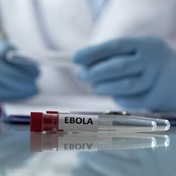
Caring for Ebola patients produces a mountain of potentially contaminated material. The disease causes substantial sweating, bleeding and vomiting and the virus can, via these bodily fluids, easily be transferred to medical equipment as well as protective gear worn by medical personnel.
The Los Angeles Times and others have reported that one Ebola patient treated in a US hospital would generate eight 55-gallon barrels of medical waste per day.
As Ebola can be spread through direct contact with surfaces or equipment, including bed linen, which have been contaminated with infected body fluids, these must all be sterilised or destroyed after use.
Read: Ebola can jump from animals to people in Africa
Surprisingly, according to the World Health Organisation (WHO), Ebola waste can be effectively disposed of using standard procedures for medical waste: the virus is not thought to be particularly hardy and can be eliminated relatively easily with heat, alcohol-based products and bleach.
However, because the virus is so highly virulent, and because its persistence in the environment outside the human body has not been extensively studied, many authorities – such as the Centers for Disease Control and Prevention (CDC) in the United States – consider that only high-temperature destruction of waste, preferably by incineration, is acceptable.
But not all hospitals, even in first world contexts, are equipped with appropriate incineration facilities, which may require transporting waste to the few that do.
Image: A hazmat worker with the US Protect Environmental Agency places an item into one of the waste barrels at The Village Bend East apartment complex in Dallas, Texas where a second health care worker who has tested positive for the Ebola virus resides on October 15, 2014. Nurse Amber Vinson joins Nina Pham as health workers who have contracted the Ebola virus at Texas Heath Presbyterian Hospital while treating patient Thomas Eric Duncan, who has since died. Photo by Mike Stone/Getty Images.
Read: Why did the Ebola outbreak occur in west Africa?
Strict PPE and training needed to handle Ebola waste
The same personal protective equipment (PPE) worn by medical personnel caring for Ebola patients is required for people handling waste materials and cleaning hospital rooms: at a minimum, disposable gloves, a fluid-resistant gown, eye protection (preferably goggles) to prevent splashes, a face mask and closed impermeable shoes – to protect against viral contaminants as well as contact with the disinfectants used.
Waste disposal personnel also go through rigorous training to prepare them for their task.
Sharp, hard objects like needles and tubing that has been in contact with body fluids should be placed inside puncture-resistant waste containers.
Solid, non-sharp, infectious waste must be placed in leak-proof waste bags and covered bins. Bins should never be carried against the body, for example on the shoulder.
Read: US medics to start staffing Ebola hospital in Liberia
Ebola waste should be incinerated – but can also be buried
Destroying medical waste in an industry-standard incinerator is the preferred end-point according to the CDC. Waste may also be rendered harmless in an autoclave - a chamber that subjects the waste to steam at high pressure and temperature.
However, in settings where safe complete incineration may not be available, the WHO recommends burying waste.
Image: A group of health officers from the Doctors Without Borders team burn contaminated medical waste at the Ebola Health Center that they founded in Gueckedou region of Guinea, on September 17, 2014. Photo by Fabien Offner/Anadolu Agency/Getty Images.
Solid waste should be placed in a pit 2 metres deep and filled to a depth of 1-1.5 m. After each wasteload, the waste is covered with a layer of soil 10-15 cm deep. The area designated for the final treatment and disposal of waste should have controlled access to prevent entry by animals, untrained personnel or children.
The WHO states that waste such as faeces, urine and vomit, and liquid waste from washing, can be disposed of in the sewerage system or even a pit latrine, with no further treatment necessary.
Read: Liberia health workers' strike on Monday could hurt Ebola efforts
All surfaces of the hospital room housing an Ebola patient must be carefully cleaned, at least once a day.
The Ebola virus, while being highly infectious, is not believed to be particularly persistent in the environment outside the body. Thus it is easily destroyed by many standard disinfectants (including bleach). However, given Ebola’s virulence, the CDC recommends cleaning with disinfectants usually used to kill “tougher” viruses like polio and flu.
Surprisingly, the WHO states that bed linen used by Ebola patients can be reused, as long as it can be machine washed with suitable detergents. Otherwise, incineration is recommended.
Read more:
Is it Ebola or is it flu?
The Ebola outbreak so far
WHO admits botched response to Ebola
References:
CDC Ebola Medical Waste Management
WHO Ebola virus disease fact sheet 103
WHO Interim Infection Prevention and Control Guidance
Image: Ebola waste warning, Shutterstock




 Publications
Publications
 Partners
Partners














